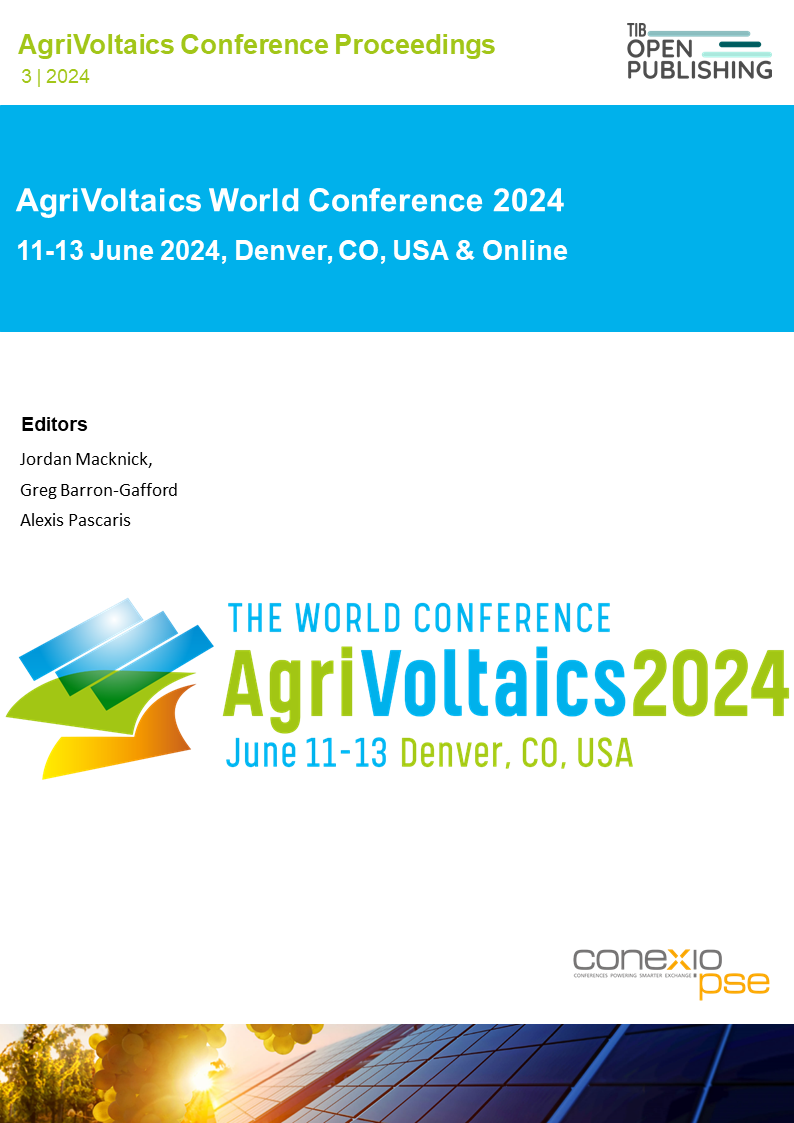Equity and Justice Implications for the Development and Deployment of Agrivoltaics Systems
DOI:
https://doi.org/10.52825/agripv.v3i.1385Keywords:
Agrivoltaics, Energy Equity and Justice, Stakeholders, Community Engagement, Dual Land Use, Frontline CommunitiesAbstract
This paper addresses the equity and justice issues that are directly related to agrivoltaics, largely through the lens of farmers and other rural stakeholders, but also to some extent through the eyes of commercial developers. Though clearly different in nature, both small-scale and utility-scale projects must address the equity and justice concerns of stakeholder communities in order to be successful. Further, while the ideas and principles discussed here are mostly U.S.-centric, they still apply to similar settings around the globe. The paper first reviews the concept of energy justice, drawing a distinction between justice and equity. It then moves on to the ways in which equity and justice are more specifically realized in agrivoltaics applications. Some of the main equity and justice issues are identified, particularly as they constitute barriers (real or perceived) that detract from more rapid adoption and deployment of agrivoltaics technology. In addition, the paper considers the differences in equity and justice associated with non-rural agrivoltaics applications; and it concludes with some general principles that should be followed to ensure the development and deployment of this emerging technology achieves overall success.
Downloads
References
National Renewable Energy Laboratory (NREL), “Benefits of agrivoltaics across the food-energy-water nexus,” 2019, https://www.nrel.gov/news/program/2019/benefits-of-agrivoltaics-across-the-food-energy-water-nexus.html (accessed December 15, 2024).
S. Ates, S. N. Kassam, F. Ozdemir, M. Louhaichi, A. Andrew, C. W. Higgins, “Potential of agrivoltaic production systems to alleviate poverty within resource poor communities in dryland areas,” Opinion Paper, AgriSolar Clearinghouse, 2022, https://agrisolarclearinghouse.org/wp-content/uploads/2022/02/Potential-of-agrivoltaic-production-systems-to-alleviate-poverty-within-resource-poor-communities-in-dryland-areas.pdf.
L. J. Watson, T. Barley, I. Bhandari, B. Campbell, J. McCall, H. M. Hartmann, A. G. Dolezal, “Opportunities for agrivoltaic systems to achieve synergistic food-energy-environmental needs and address sustainability goals,” Frontiers in Sustainable Food Systems, vol. 6, paper 932018, 2022, https://www.frontiersin.org/articles/10.3389/fsufs.2022.932018/full. DOI: https://www.doi.org/10.3389/fsufs.2022.932018.
M. Taylor, J. Pettit, T. Sekiyama, M. M. Sokolowski, “Justice-driven agrivoltaics: Facilitating agrivoltaics embedded in energy justice,” Renewable and Sustainable Energy Reviews, vol. 188, paper 113815, 2023. DOI: https://doi.org/10.1016/j.rser.2023.113815.
U.S. Department of Agriculture (USDA), “Rural Energy for America Program (REAP), Announcing $145 million to expand access to renewable energy and lower energy costs for rural Americans,” n.d., https://www.rd.usda.gov/inflation-reduction-act/rural-energy-america-program-reap (accessed December 15, 2024).
K. McQuire, “Common ground for agriculture and solar energy: Federal funding supports research and development in agrivoltaics,” USDA Economic Research Service: Amber Waves, April 22, 2024, https://www.ers.usda.gov/amber-waves/2024/april/common-ground-for-agriculture-and-solar-energy-federal-funding-supports-research-and-development-in-agrivoltaics.
Colorado Department of Agriculture, “Agrivoltaics grants,” 2024, https://ag.colorado.gov/conservation/agricultural-drought-and-climate-resilience-office-adcro/agrivoltaics-grants (accessed December 15, 2024).
K. Jenkins, D. McCauley, R. Heffron, S. Hannes, R. Rehner, “Energy justice: A conceptual review,” Energy Research & Social Science, vol. 11, pp. 174-182, 2016. DOI: https://doi.org/10.1016/j.erss.2015.10.004.
R. J. Heffron, D. McCauley, “The concept of energy justice across the disciplines,” Energy Policy, vol. 105, pp. 658-667, 2017. DOI: https://doi.org/10.1016/j.enpol.2017.03.018.
S. Carley, D. M. Konisky, “The justice and equity implications of the clean energy transition,” Nature Energy, vol. 5, pp. 569-577, 2020. DOI: https://doi.org/10.1038/s41560-020-0641-6.
R. Wallsgrove, J. Woo, J.-H. Lee, L. Akiba, “The emerging potential of microgrids in the transition to 100% renewable energy systems,” Energies, vol. 14, no. 6, paper 1687, 2021, https://www.mdpi.com/1996-1073/14/6/1687. DOI: https://doi.org/10.3390/en14061687.
B. Sovacool, R. J. Heffron, D. McCauley, A. Goldthau, “Energy decisions reframed as justice and ethical concerns.” Nature Energy, vol 1, paper 16024, 2016, https://doi.org/10.1038/nenergy.2016.24.
Pacific Northwest National Laboratory (PNNL), “Energy equity,” n.d., https://www.pnnl.gov/projects/energy-equity.
E. Baker, S. Carley, S., Castellanos, D. Nock, J. F. Bozemann III, D. Konisky, C. G. Monyei, M. Shah, B. Sovacool, B, “Metrics for decision-making in energy justice,” Annual Review of Environment and Resources, vol. 48, pp. 737-760, 2023. DOI: https://doi.org/10.1146/annurev-environ-112621-063400.
J. Heeter, T. Reames, “Incorporating energy justice into utility-scale photovoltaic deployment: A policy framework,” Renewable Energy Focus vol. 42, pp. 1-7, 2022. DOI: https://doi.org/10.1016/j.ref.2022.04.003.
W. Leon, C. Farley, N. Hausman, B. Herbert, N. Hernandez Hammer, B. Paulos, T. Reames, R. Sanders, L. Schieb, D. Deane-Tyan, R. Navarra, “Solar with justice: Strategies for powering up under-resourced communities and growing and inclusive solar market,” Clean Energy States Alliance, 2019, https://www.cesa.org/projects/solar-with-justice.
J. D. Bourdeau, J. D., “5 disadvantages that prevent widespread deployment of agrivoltaics,” The Momentum, 2022, https://www.themomentum.com/roundups/5-disadvantages-that-prevent-widespread-deployment-of-agrivoltaics.
Z. Goldberg, “Solar energy development on farmland: Three prevalent perspectives of conflict, synergy, and compromise in the United States,” Energy Research and Social Sciences, vol. 101, paper 103145, 2023, https://www.sciencedirect.com/science/article/abs/pii/S2214629623002050. DOI: https://doi.org/10.1016/j.erss.2023.103145.
K. W. Proctor, G. S. Murthy, C. W. Higgins, “Agrivoltaics align with Green New Deal goals while supporting investment in the US’ rural economy,” Sustainability, vol. 13, no. 1, paper 137, 2021, https://www.mdpi.com/2071-1050/13/1/137. DOI: https://doi.org/10.3390/su13010137.
S. Moore, H. Graf, C. Ouellet, S. Leslie, D. Olweean, D., “Can we have clean energy and grow our crops too? Solar siting on agricultural land in the United States,” Energy Research & Social Science vol. 91, paper 102731, 2022, https://www.sciencedirect.com/science/article/abs/pii/S2214629622002353. DOI: https://doi.org/10.1016/j.erss.2022.102731.
G. Torma, J. Aschemann-Witzel, “Social acceptance of dual land use approaches: Stakeholders’ perceptions of the drivers and barriers confronting agrivoltaics diffusion,” Journal of Rural Studies, vol. 97, pp. 610-625, 2023. DOI: https://doi.org/10.1016/j.jrurstud.2023.01.014.
K. K. DuVivier., “Mobilizing microgrids for energy justice,” Stanford Technology Law Review, vol. 26 pp. 250-315, 2023.
J. Bousselot, T. Hickey, Jr., “Exploring the potential of rooftop agrivoltaics,” Architecture Monitor, Spring 2022, https://livingarchitecturemonitor.com/articles/potential-rooftop-agrivoltaics-sp22.
Published
How to Cite
Conference Proceedings Volume
Section
License
Copyright (c) 2025 Timothy Coburn, Steven Conrad, Thomas Bradley, Alexander Lynch, Isabella Amyx

This work is licensed under a Creative Commons Attribution 4.0 International License.
Accepted 2025-01-31
Published 2025-03-26
